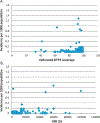Vaccine preventable diseases: time to re-examine global surveillance data?
- PMID: 24625342
- PMCID: PMC10746379
- DOI: 10.1016/j.vaccine.2014.02.067
Vaccine preventable diseases: time to re-examine global surveillance data?
Abstract
While data driven estimates of the global burden of disease for some vaccine preventable diseases (VPDs) are limited, aggregate case numbers of VPDs are reported annually by country in the Joint Reporting Form (JRF). We examined pertussis surveillance data in the JRF, and vaccine coverage estimates, in comparison to measles, which is a priority disease for elimination and eradication efforts and is supported by the WHO Global Measles and Rubella Laboratory Network. In 2012, highest pertussis case numbers and incidence were reported from high income countries with high vaccine coverage, discordant with countries that had low vaccine coverage. Use of laboratory diagnostics for pertussis cases varied among countries. In contrast, highest reported numbers of measles cases and incidences tended to occur in low income countries. These observations imply poor quality global surveillance data for some VPDs, limiting capacity for monitoring global epidemiology or making vaccination policy decisions. Efforts are needed to improve the availability of quality surveillance data for all VPDs.
Keywords: Data; Measles; Pertussis; Surveillance; Vaccine preventable disease.
Copyright © 2014. Published by Elsevier Ltd.
Figures
References
-
- Tracking progress towards global polio eradication 2011–2012. Releve epidemiologique hebdomadaire/Section d’hygiene du Secretariat de la Societe des Nations 2013;88(April (15)):153–60. - PubMed
-
- Progress in global control and regional elimination of measles, 2000–2011. Releve epidemiologique hebdomadaire/Section d’hygiene du Secretariat de la Societe des Nations 2013;88(January (3)):29–36. - PubMed
-
- Nsubuga P, Perry H, Embrey K, Duale S. In: Kasolo F, Roungou JB, Perry H, editors. Technical guidelines for integrated disease surveillance and response in the African region. 2nd ed. Geneva: WHO; 2010.
-
- WHO. Global invasive bacterial vaccine preventable diseases (IB-VPD) information and surveillance bulletin; 2013. http://www.who.int/nuvi/surveillance/IB_VPD_bulletin_Jan_Jun_2012_Final.pdf
-
- WHO. Global rotavirus information and surveillance bulletin; 2013. http://www.who.int/nuvi/surveillance/RV_bulletin_Jan_June_2012_Final.pdf
MeSH terms
Grants and funding
LinkOut - more resources
Full Text Sources
Other Literature Sources
Medical



